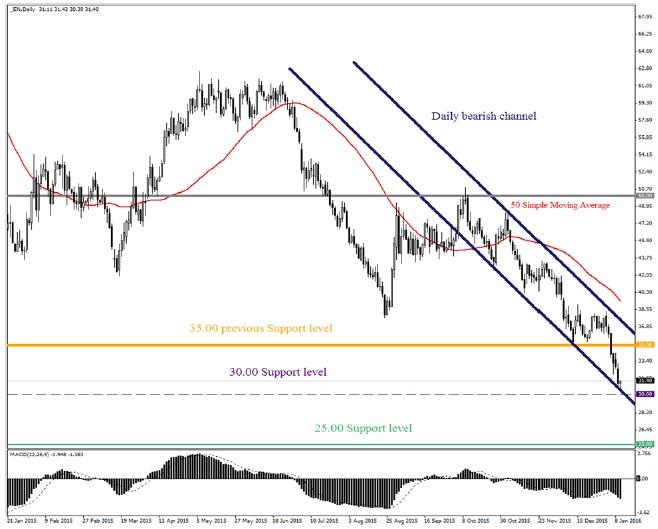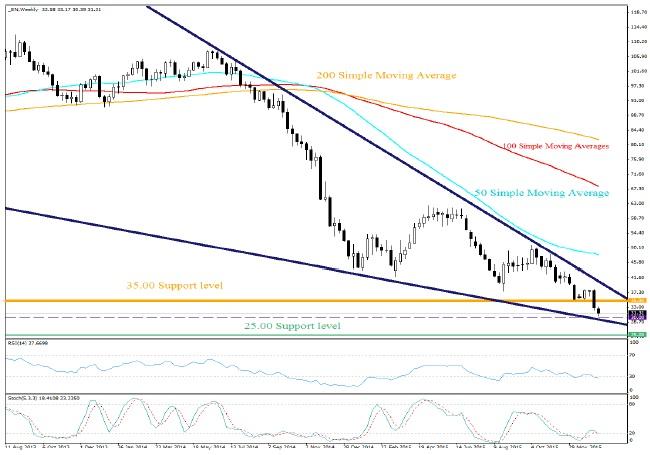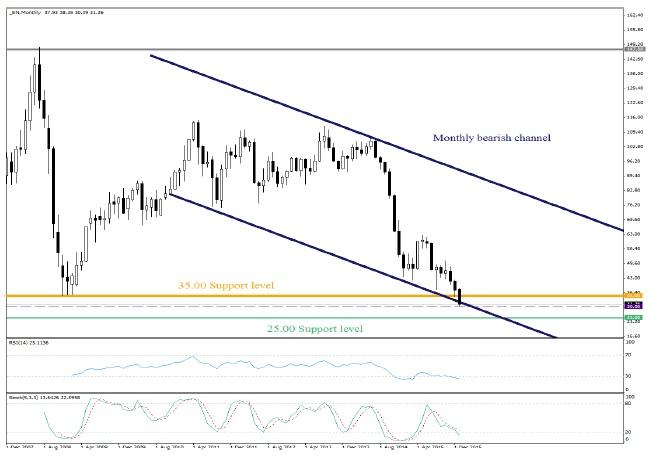The early trading weeks of 2016 have seen the return of brutal punishment in the oil markets with WTI oil being repeatedly crushed and having found itself falling to its lowest level in over a decade below $30.50. The value of the commodity has already extended its decline by around a further 20% this year and although this is another astonishing drop following continual selling throughout last year, which has ultimately led to prices falling nearly 80% from its peaks just eighteen months ago, the dismal outlook is still favored towards additional declines. The overwhelming supply and demand equation that has encouraged dramatic selling is going nowhere anytime soon, with a persistent aggressive oversupply in the markets consistently haunting investor attraction, while weaker forecasts around global growth weighs on demand, and it is likely that more global economic downgrades from major institutions are to follow early this year.
It has not only become incredibly difficult to argue for a case to purchase oil, but also to simply structure a viewpoint from where prices can rebound and maintain themselves without entering yet another round of selling. The economic conditions are quite simply so overwhelmingly and aggressively against the commodity that there is still no visible floor for oil weakness. Another reason why it is difficult to find a floor despite further aggressive declines which are putting us within touching distance of entering the $20 range is because Iran has not yet began to unleash its own production potential, which would even further squash the already aggressive supply and demand equation towards the momentum of sellers. Both equity markets and central banks have still not digested such prolonged weakness in the oil markets, and it wouldn’t surprise me in the slightest if central banks or other policymakers resume to change policy taking into account the prolonged weakness in commodities that are vital to their exports.
Many are wondering how producers can handle such depressed prices and were eagerly awaiting to see if this impacts the United States, but traders are now losing patience with no correlation yet to be seen between declining US oil rigs and the weekly inventory reports released from the United States. Comments late last year from Saudi Arabia that it would be willing to collaborate with others to achieve stability in the markets provided some promise to those hoping for a rebound in sentiment, but there are concerns that the recent escalation in political tensions between Saudi Arabia and Iran will make any combined production cut from major producers difficult. It should also be taken into account how difficult it would be to bring leaders from so many different economies around the globe together to collectively agree on production levels. Although the situations are entirely different, it was only a few months ago that the headlines were focused on the Greece situation and these were collective discussions between very senior figures in the same European Union. You would just have to imagine how difficult it would be to find an agreement on a production ceiling for members of the OPEC committee group, let alone finding producers outside of OPEC to join and cut production also.
In regards to the technicals, all of the charts paint a depressing picture and showcase how sellers are clearly in control of this market. Starting with the daily timeframe, prices are clearly trading inside a steep bearish channel with $30 acting as a major support level. Bears are clearly in control and as long as prices can continue to trade below $35, a breakdown below $30 invites a further potential selloff towards $25. The monthly timeframe also suggests that $35 is now a heavy resistance level and was previously seen as major support. Previous support at $35 is now going to be seen as major resistance, and any failure to close above this level will likely invite opportunities for investors to enter another sellon rally opportunity. The weekly timeframe also shows that prices are compressing heavily to the downside. Last week’s bearish engulfment combined with the fact that prices are below the weekly 50,100 and 200 SMA should encourage a further selloff towards $30. A weekly close below $30 may suggest another buildup in bearish momentum which can invite sellers to attack prices now seen since April 2003 at $25.
WTI Daily Chart:
WTI Weekly Chart:
WTI Monthly Chart:
Comparebroker is a comparison site and we spend hundreds of hours to keep the information up to date. However, users are advised to do their own due diligence and nothing can be perceived any advise. The content on the website is purely for education purposes only
Recommended Content
Editors’ Picks
EUR/USD clings to gains above 1.0750 after US data

EUR/USD manages to hold in positive territory above 1.0750 despite retreating from the fresh multi-week high it set above 1.0800 earlier in the day. The US Dollar struggles to find demand following the weaker-than-expected NFP data.
GBP/USD declines below 1.2550 following NFP-inspired upsurge

GBP/USD struggles to preserve its bullish momentum and trades below 1.2550 in the American session. Earlier in the day, the disappointing April jobs report from the US triggered a USD selloff and allowed the pair to reach multi-week highs above 1.2600.
Gold struggles to hold above $2,300 despite falling US yields

Gold stays on the back foot below $2,300 in the American session on Friday. The benchmark 10-year US Treasury bond yield stays in negative territory below 4.6% after weak US data but the improving risk mood doesn't allow XAU/USD to gain traction.
Bitcoin Weekly Forecast: Should you buy BTC here? Premium

Bitcoin (BTC) price shows signs of a potential reversal but lacks confirmation, which has divided the investor community into two – those who are buying the dips and those who are expecting a further correction.
Week ahead – BoE and RBA decisions headline a calm week

Bank of England meets on Thursday, unlikely to signal rate cuts. Reserve Bank of Australia could maintain a higher-for-longer stance. Elsewhere, Bank of Japan releases summary of opinions.


